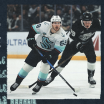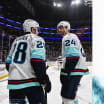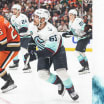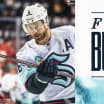The first thing for Kraken fans to know about standard-size hockey rinks in North America is the length of the ice surface is 200 feet. That informs the term, "200-foot player," which refers to hockey forwards who excel on both the offensive and defensive ends of a rink.
If you are still learning the sport, feel free to use this new dimensional knowledge in a sentence to impress hockey-savant friends: "That player has a strong 200-foot game."
Measuring and Marking Up
There's no hockey without a rink, which is obvious. But less known are the dimensions and markings of regulation ice sheets. Here's a 'Hockey 1.0' primer for Kraken fans
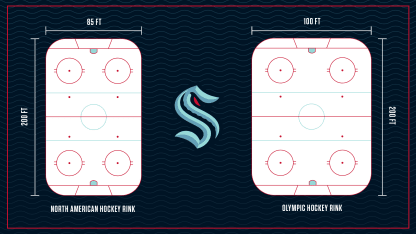
One such player? Kraken GM Ron Francis, who ranks fifth among all-time leading scorers in the NHL and second in assists (only the legendary Wayne Gretzky had more). Francis won the league's Selke Trophy as the forward who "demonstrates the most skill in the defensive aspects of the game" for the 1994-95 season and was a top-eight nominee six straight years.
Make no mistake: Francis and his hockey operations staff will be looking for 200-foot players in the NHL Expansion Draft July 21 and the league's amateur draft July 23 and 24, especially at the center position.
Back to the rink dimensions. The standard width of North American rinks is 85 feet. In Europe, the standard competition rink is also 200 feet long but typically about 100 feet wide, providing an additional 15 feet of room for skaters and playmakers to maneuver.
Speaking of extra room, the space behind the goal lines is 11 feet deep in North American rinks, but another two feet wider on Euro and Olympic rinks. It doesn't sound like a lot, but it no doubt adds intrigue options to playmaking in the offensive zone (also called the attacking zone).
The Olympics are typically staged on the wider rink, though the 2010 Winter Olympics hockey tournament and its classic gold-medal overtime game between victorious Canada and USA was played on the NHL rink in Vancouver. Cheer up, American compatriots, we'll always have the 1980 "Miracle" win over Russia and subsequent USA gold medal ceremony at Lake Placid, which was in fact played on a wider Olympic-size rink.
That's two dimensions, length and width. The depth of a rink is conditional on whether you are including the concrete slab covering the refrigeration system underneath the ice or just the ice itself. Both answers will be subject to another "Hockey 1.0-type" story in coming weeks, but for now you might be surprised to learn the thickness of NHL ice (the rink's third dimension of depth) is typically less than an inch.
Much more about that cool fact (pun intended) in the weeks ahead as both Climate Pledge Arena and the Kraken Training Center (three rinks!). We'll talk ice, boards, benches, penalty boxes and other rink characteristics. We promise.
Knowing about the markings on the ice surface can help fans of all levels enjoy the sport more. Let's review the lines, circles, semicircles and trapezoids. For visual learners, this story includes an explanatory graphic about goal creases, red, blue and goal lines, faceoff circles and more. It includes measurements for the markings too.
The "goal line" inside the "goalie crease" is arguably the most vital marking on the ice. A puck must cross the two-inch red line completely to register as a legal goal. The goalie's semi-circle crease sits in front of that goal line and is marked in a semicircle.
This represents the goalie's domain. There was a time when opposing players were not allowed to enter the goal crease without nullifying a resulting goal. The revised rule, according to the NHL rule book, is "intended to implement a 'no harm, no foul, no video review' standard" and "based on the premise that an attacking player's position, whether inside or outside the crease, should not, by itself, determine whether a goal should be allowed or disallowed."
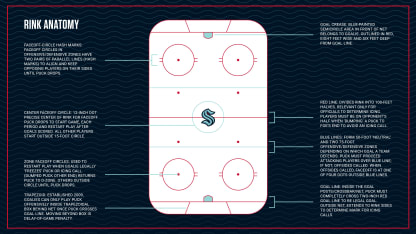
Whew, OK, let's talk about other line markings. The center-ice "red line" divides the rink into 100-foot halves. It is relevant for "icing," which is "dumping" or shooting the puck out of danger to the opponent's defensive half of the ice. A player must be over the red line to avoid such an icing call.
Each "blue line" establishes offensive and defensive zones that are 75-foot long to go with the 85-foot depth. A team's defensive zone is the one in which it is protecting the puck from entering its net (aka goal) while the offensive zone is the one in which the team is attacking the opponent's net.
The blue line is relevant dozens of times during games with on-ice officials making sure attacking players are not entering the offensive zone before the puck enters. When offsides is called, one of the outside dots will be the faceoff site when play resumes.
The 50-foot middle zone between the blue lines is called the "neutral zone."
There are five "faceoff circles" and four additional "faceoff dots" that host two opposing players vying for a puck dropped by an official while all other players are outside the circles and regulated by hash marks (see accompanying graphic).
The faceoff circle at center ice is used to start games, each period and restarting play after goals are scored.
The other four faceoff circles, two in each zone, are most frequently used when a puck is "frozen" or held for a whistle by a goaltender (provided there is a perceived scoring threat by the opposing team) or when referees call icing. Which circle is engaged (right or left of the goaltender) depends on which side the puck was frozen or called for icing.
The goal line in the goalie crease extends out to each side of the rink. These portions of the goal line are used to determine an icing call; the puck must fully cross the line to be eligible for an icing call. Hockey players also know the darker side of the goal line: It's where a team lines up when the coach wants to run skating drills that build stamina-hockey's version of wind sprints.
There are two more NHL ice markings of significance for Kraken fans. One is the semi-circle crease (10-foot radius) at center ice near the scorekeeper's box. It is a safe zone for referees while consulting calls or listen/watch reviewed plays with the league's hockey operations control room in Toronto. No players are allowed to enter the crease to argue or disrupt the process, though a team captain can sometimes be granted permission to enter the crease.
Keen observers will note there are slanted lines behind each goal that form a trapezoid-shaped area. The hockey "trapezoid" marks off the only area that goalies are allowed to play the puck offensively and only once a puck has crossed the goal line.
The rule, established in 2009, is intended to make it harder for goalies to clear a puck from the defensive zone. Playing a puck outside of the trapezoid can result in a two-minute penalty (leaving the team short one skater because a teammate serves the penalty instead of the goalie).
Hall of Fame goalie Martin Brodeur, inducted in 2018, earned the honor for his many goaltending records and three Stanley Cup titles, but is also regarded as one of the all-time best handlers of the puck for offensive purposes among goalies. Many hockey fans call this marked restricted area the Martin Brodeur Trapezoid because the trapezoid rule was established for the 2005-06 season at the height of Brodeur's stardom.

